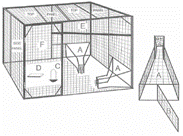Eastern Wildlife Damage Control Conferences
Date of this Version
October 1997
Document Type
Article
Abstract
Ring-billed gulls ( Larus delewarensis) and double-crested cormorants ( Phalacrocorx auritus) have nested on Lake Champlain since 1949 and 1982, respectively. Recent increases in cormorant nesting populations and pioneering activities of both species to previously uncolonized islands have resulted in impacts related to accumulation of bird guano and interspecific competition with less common species. Of primary concern are: decreases in wildlife and plant diversity on islands; reduced aesthetics and property values of island associated with the loss of trees; and predation or competition for nesting space with other species such as the state-endangered common tern (Sterna hirundo). In addition, public concerns have been raised over potential impacts to fish species by cormorants, as well as urban-suburban gull activity impacting human health and safety and property. Nine stakeholder meetings have been held since 1990, to consider prospective management strategies for gulls and cormorants on Lake Champlain, Vermont. Since 1994, limited site-specific control efforts have been conducted by USDA-APHIS-ADC (ADC) at the request of the Vermont Fish and Wildlife Department (VFWD) and private landowners who recently experienced damage from these species. A technique for the removal of cormorant nests in trees has been developed and tested by ADC using portable pumps to deliver pressurized water to remove the nests. This technique has proven successful in tree nests up to approximately 15 m. Also, an alternative method is being tested to selectively remove nesting cormorants from a great blue heron (Ardea herodius) rookery. Currently, a draft environmental assessment is being prepared cooperatively by VFWD and ADC that explores alternatives for future management over 5 years beginning in 1998. Extensive public involvement using a variety of approaches will occur during the summer of 1997. VFWD, in cooperation with ADC, will continue to approach damage management on Lake Champlain for these species on a site-specific basis while working toward a more comprehensive interstate and international agreement on goals for basin-wide population and ecosystem management.



Comments
Published in Proceedings of the Eighth Eastern Wildlife Damage Management Conference, Roanoke, Virginia, October 16–19, 1997, edited by James A. Parkhurst. Copyright © 1997 by the authors.